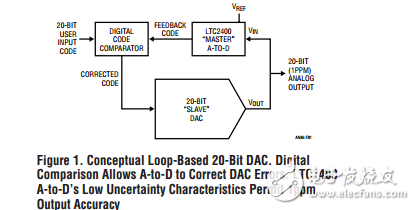
资料下载

20位数字模拟转换器的使用
简介
高精度,仪器仪表的重大进展等级A转换器最近发生。十年前12位的数-模转换器(DAC)被认为是高级设备。今天,16位DAC可在系统设计中越来越普遍。这些都是真的不到1lsb线性误差和精密设备1ppm的/°C漂移。1然而,在DAC的应用这需要更高的性能。自动测试设备、仪器、校准装置、激光机,医疗电子和其他应用经常要求DAC精度超过16位。18位DAC有在电路装配形式,虽然他们是价格昂贵,需要经常校准。20、即使23 +(0.1ppm!)位DAC由手动交换Kelvin Varley分频器。这些设备,虽然惊人的准确,大,慢,非常昂贵。他们的使用通常只限于标准实验室。2有用的发展将是一个现实,20位(1ppm)DAC很容易构造,不需要频繁的校准。
20-Bit DAC Architecture
Figure 1 diagrams the architecture of a 20-bit (1ppm) DAC. This scheme is based on the availability of a true 1ppm analog-to-digital converter with scale and zero drifts below 0.02ppm/°C. This device, the LTC® 2400, is used as a feedback element in a digitally corrected loop to realize a 20-bit DAC.3
In practice, the “slave” 20-bit DAC’s output is monitored by the “master” LTC2400 A-to-D, which feeds digital information to a code comparator. The code comparator differences the user input word with the LTC2400 output, presenting a corrected code to the slave DAC. In this fashion, the slave DAC’s drifts and nonlinearity are continuously corrected by the loop to an accuracy determined by the A-to-D converter and VREF4. The sole DAC requirement is that it be monotonic. No other components in the loop need to be stable.

声明:本文内容及配图由入驻作者撰写或者入驻合作网站授权转载。文章观点仅代表作者本人,不代表电子发烧友网立场。文章及其配图仅供工程师学习之用,如有内容侵权或者其他违规问题,请联系本站处理。 举报投诉
- 相关下载
- 相关文章





